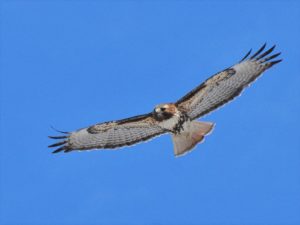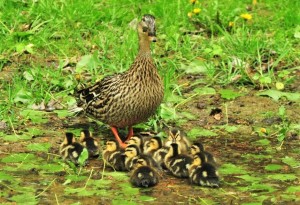Photography courtesy of Lowell Washburn, all rights reserved.
Ask any duck hunter what he or she considers to be the smartest duck and they’re likely to list the mallard as a top contender. Whoever coined the phrase “Bird Brain” certainly wasn’t referring to the noble Greenhead. As elusive as they are gaudy, mallard ducks rarely come straight to the decoys. Instead, they prefer to cautiously inspect the spread from a distance, warily circling round and round until finally heading for safer waters. But even though mallard hunting often proves to be a humbling experience, most duck hunters remain largely unaware of the species’ intellectual potential.
Earlier this summer, I received a firsthand demonstration of the duck’s ability to sort things out when two mallard pairs established temporary territories on my backyard pond. At first, the ducks would nosily take to the air in panicked retreat whenever we would appear in the yard. Following their departure, I’d toss a couple handfuls of shelled corn at water’s edge, which the ducks would eagerly consume as soon as they returned.
It soon became evident that the way to a mallard’s heart is through its stomach. As time passed, the ducks began to figure out that I was much less dangerous than they had assumed. Before long, the ducks would merely swim to the far edge of the pond and wait for the daily ration of corn to be dropped near the water. A week later, the birds would swim to their free lunch as soon as we turned our backs to walk away. A week after that, and the ducks actually began lounging a few yards from the back door as they patiently waited for their daily handout. For a bird to go from panicked exit to begging for food in less than three weeks takes an advanced level of intelligence. Like I said, whoever coined the phrase “Bird Brain” probably wasn’t referring to the mallard duck.
As the season continued, both hens were soon setting on hidden nests. Following a several days of incubation, one of the ducks reappeared to begin hanging around the yard again. Her nest was lost and had most likely provided a midnight snack for a hungry skunk or raccoon. Two weeks later, the second hen showed up. This time, the outcome of the nesting effort was much more positive; the duck was accompanied by a waddling chain of twelve olive and chocolate ducklings.
Seeing that boisterous brood of ducklings made me think back to another, decisively more unusual, incident that occurred during the summer of 2013. It had been another very wet year. Parts of my lawn had been underwater for the better part of a month and a pair of mallards had taken up residence on one of the larger puddles. Upon selecting a secret nest site, the hen was soon incubating her clutch of eggs. As is typical for mallards, the drake abandoned the site after the hen had been setting for 10 or 12 days.
Although she never became as tame as this year’s ducks, the hen would briefly appear on the lawn each afternoon. After gleaning spilled seeds from beneath the backyard bird feeders, the hen would grab a drink from the puddle and then quickly return to her hidden nest. The daily routine continued in a calm and predictable fashion until, during the final week of incubation, the scenario suffered a dramatic turn of events.
Peering from the kitchen window one afternoon, I could scarcely believe my eyes. Right on schedule, the hen was in her usual spot near the feeders. But on this occasion, she wasn’t looking for spilled grain. Instead, the duck was lying flat on the ground — 15 yards from the house — with a mature red-tailed hawk standing over her back. Making the best of the unusual situation, I grabbed the camera and documented the incident by taking several ‘voucher photos’ through the kitchen’s double-paned glass. Dropping below the sill, I attempted to quietly open the window for a sharper picture. I was about to make my move, when the mallard suddenly flexed her left wing. It was my first indication that the duck might still be alive.
The red-tail remained as motionless as a bronze statue. Surveying its surroundings for potential danger, the hawk stood with one foot completely wrapped around the hen’s neck; the other leg planted firmly on the ground.
As a licensed falconer, I’ve had opportunity to see lots of hawks make lots of kills. What had happened here was becoming crystal clear. Falling from the sky, the hawk had caught the unsuspecting duck just seconds before I discovered the scene. Still scanning for possible danger, the raptor had not yet dispatched its prey.
Seeing the movement of my hand at the window, the alert red-tail released its grip and immediately took wing. Just as quickly, the mallard hen was back on her feet – feathers ruffled, but otherwise unharmed. Ignoring the nearby pond and spilled bird seed, the terrified hen lost no time in retreating to thick cover. As she disappeared, I couldn’t help but wonder if the duck realized how extremely fortunate she was. Once a red-tailed hawk has its foot securely wrapped around a bird’s neck, the chances of that bird surviving are slim and none. My surprise appearance at the window had cost the hawk its meal and had also spared the mallard’s life. Whether my intrusion was good or bad is purely a matter of perspective.
Two mysteries remained. The first was why a red-tail would pin a full-grown mallard to my lawn when easier prey was currently more abundant. Although winter hardened red-tails routinely subdue larger quarry such as cottontail rabbits or fox squirrels; their aggression usually wanes as smaller game such as mice, ground squirrels and garter snakes become increasingly plentiful during summer.
The second mystery was whether or not the ruffled duck would return to her nest. Perhaps the sheer terror of being caught by the formidable winged predator would be enough to make her abandon the effort.
Although I’ll never know what possessed that red-tail, the second mystery was solved when, three days later, the mallard hen suddenly reappeared in the backyard. It was a happier occasion. The duck was being closely followed by eleven energetic, newly hatched ducklings. Documenting the event with another set of voucher photos, I suddenly realized that the hen and her new brood were standing less than six feet from where the big red-tail had pinned the duck to the ground just three days earlier. Sometimes fact really is stranger than fiction.
LW




 Susan Judkins Josten
Susan Judkins Josten Rudi Roeslein
Rudi Roeslein Elyssa McFarland
Elyssa McFarland Mark Langgin
Mark Langgin Adam Janke
Adam Janke Joe Henry
Joe Henry Sue Wilkinson
Sue Wilkinson Tom Cope
Tom Cope Kristin Ashenbrenner
Kristin Ashenbrenner Joe Wilkinson
Joe Wilkinson Dr. Tammy Mildenstein
Dr. Tammy Mildenstein Sean McMahon
Sean McMahon